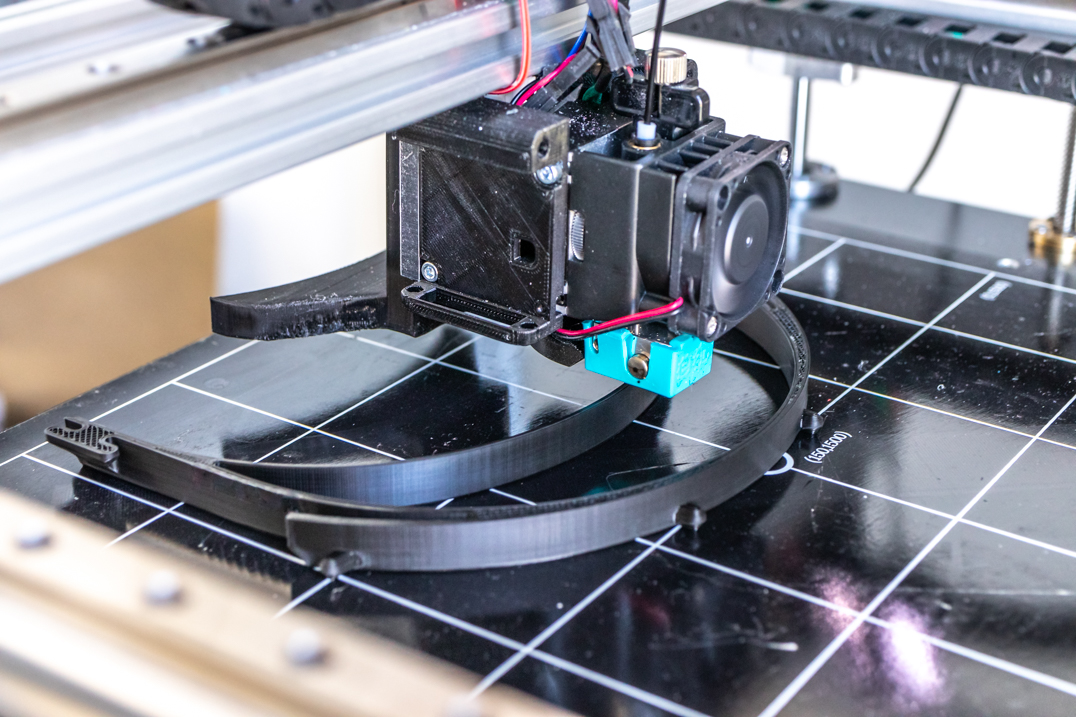News & Press
Help from the 3D Printer
livMatS is participating in an initiative that produces face shields for medical professionals

The initiative "Techies vs. Corona" uses 3D printers from the University of Freiburg to produce face shields.
In times of the corona pandemic, protective clothing is in short supply in hospitals, retirement homes and doctors' practice. A team of Freiburg researchers has joined forces to provide help: They use 3D printers from the University of Freiburg to produce face shields for institutions that have close contact with patients. Dr. Severin Vierrath and Dr. Matthias Breitwieser from the Department of Microsystems Engineering at the University of Freiburg coordinate the initiative “Techies vs. Corona”.
livMatS has joined the initiative and produces shields in the cluster's 3D printing laboratory. Stefan Conrad, Dr. Uwe Pelz and Dr. Falk Esser are involved in the implementation. In just a few days, the initiative has delivered a total of 140 shields to the St. Josef Hospital in Freiburg, medical services and Freiburg medical practices. The team has already received more than 500 advance orders.
The printer can be used to produce the bands for the shields that enclose the wearer's head. The visor itself is made of PET foil, which is cut into shape with a laser cutter. The idea for this production method came from a Czech manufacturer of 3D printers. Prof. Dr. Benedikt Spies, Medical Director of the Department of Dental Prosthetics at the Freiburg University Medical Center, took up the concept and, after initial tests, asked for help with production.
This was the starting point for the formation of the initiative in Freiburg. "We are now coordinating a consortium of more than 100 Freiburg researchers from several Fraunhofer Institutes, several faculties of the University of Freiburg, the 'FREILab', some technically experienced private individuals and the Freiburg members of the 'makervsvirus' network," said Vierrath. Together, the initiative has more than 80 printers and several laser cutters.

The printer can be used to produce the mounts for the shields that enclose the wearer's head.
"The challenge is that we want to produce and deliver as quickly as possible in the current situation," explains doctoral researcher Conrad. "A 3D printer can print several individual pieces at once. However, one person must manually intervene to remove the finished piece and start the next print. A lot of time is lost, especially overnight".

The 3D printer of livMatS can produce holders in one piece for days, even when no one is working in the lab.
Conrad has therefore modified the livMatS 3D printer so that it can produce autonomously over a long period of time. Once a headband has been printed, the printer can push it out of the device itself. To do this, the machine waits until the heated printing plate under the object has cooled down to 35 degrees Celsius and the material can be removed by itself. Thanks to presetting, the printer also counts how many head bands it has already printed. In this way it knows when the roll of filament, the material of the bands, is used up. The self-cleaning of the print head is also programmed so that no intervention by a person is necessary. In this way, the printer can produce head bands in one piece for days, even when no one is working in the lab.
Medical institutions in Freiburg and the surrounding area with an urgent need for face shields can submit their requests on the consortium's homepage.
